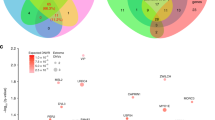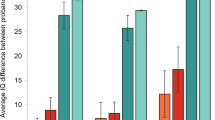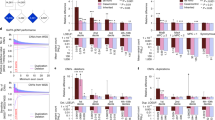Abstract
A universal challenge in genetic studies of autism spectrum disorders (ASDs) is determining whether a given DNA sequence alteration will manifest as disease. Among different population controls, we observed, for specific exons, an inverse correlation between exon expression level in brain and burden of rare missense mutations. For genes that harbor de novo mutations predicted to be deleterious, we found that specific critical exons were significantly enriched in individuals with ASD relative to their siblings without ASD (P < 1.13 × 10−38; odds ratio (OR) = 2.40). Furthermore, our analysis of genes with high exonic expression in brain and low burden of rare mutations demonstrated enrichment for known ASD-associated genes (P < 3.40 × 10−11; OR = 6.08) and ASD-relevant fragile-X protein targets (P < 2.91 × 10−157; OR = 9.52). Our results suggest that brain-expressed exons under purifying selection should be prioritized in genotype-phenotype studies for ASD and related neurodevelopmental conditions.
This is a preview of subscription content, access via your institution
Access options
Subscribe to this journal
Receive 12 print issues and online access
$209.00 per year
only $17.42 per issue
Buy this article
- Purchase on Springer Link
- Instant access to full article PDF
Prices may be subject to local taxes which are calculated during checkout





Similar content being viewed by others
References
Devlin, B. & Scherer, S.W. Genetic architecture in autism spectrum disorder. Curr. Opin. Genet. Dev. 22, 229–237 (2012).
Neale, B.M. et al. Patterns and rates of exonic de novo mutations in autism spectrum disorders. Nature 485, 242–245 (2012).
Pinto, D. et al. Functional impact of global rare copy number variation in autism spectrum disorders. Nature 466, 368–372 (2010).
Sanders, S.J. et al. De novo mutations revealed by whole-exome sequencing are strongly associated with autism. Nature 485, 237–241 (2012).
Betancur, C. Etiological heterogeneity in autism spectrum disorders: more than 100 genetic and genomic disorders and still counting. Brain Res. 1380, 42–77 (2011).
Anney, R. et al. Individual common variants exert weak effects on the risk for autism spectrum disorders. Hum. Mol. Genet. 21, 4781–4792 (2012).
Rauch, A. et al. Range of genetic mutations associated with severe non-syndromic sporadic intellectual disability: an exome sequencing study. Lancet 380, 1674–1682 (2012).
Xu, B. et al. Exome sequencing supports a de novo mutational paradigm for schizophrenia. Nat. Genet. 43, 864–868 (2011).
Gratten, J., Visscher, P.M., Mowry, B.J. & Wray, N.R. Interpreting the role of de novo protein-coding mutations in neuropsychiatric disease. Nat. Genet. 45, 234–238 (2013).
Marshall, C.R. et al. Structural variation of chromosomes in autism spectrum disorder. Am. J. Hum. Genet. 82, 477–488 (2008).
Vaags, A.K. et al. Rare deletions at the neurexin 3 locus in autism spectrum disorder. Am. J. Hum. Genet. 90, 133–141 (2012).
Lionel, A.C. et al. Disruption of the ASTN2/TRIM32 locus at 9q33.1 is a risk factor in males for autism spectrum disorders, ADHD and other neurodevelopmental phenotypes. Hum. Mol. Genet. 23, 2752–2768 (2014).
Beunders, G. et al. Exonic deletions in AUTS2 cause a syndromic form of intellectual disability and suggest a critical role for the C terminus. Am. J. Hum. Genet. 92, 210–220 (2013).
Kang, H.J. et al. Spatio-temporal transcriptome of the human brain. Nature 478, 483–489 (2011).
Khurana, E. et al. Integrative annotation of variants from 1092 humans: application to cancer genomics. Science 342, 1235587 (2013).
Petrovski, S., Wang, Q., Heinzen, E.L., Allen, A.S. & Goldstein, D.B. Genic intolerance to functional variation and the interpretation of personal genomes. PLoS Genet. 9, e1003709 (2013).
Fu, W. et al. Analysis of 6,515 exomes reveals the recent origin of most human protein-coding variants. Nature 493, 216–220 (2013).
Tennessen, J.A. et al. Evolution and functional impact of rare coding variation from deep sequencing of human exomes. Science 337, 64–69 (2012).
Iossifov, I. et al. De novo gene disruptions in children on the autistic spectrum. Neuron 74, 285–299 (2012).
Jiang, Y.H. et al. Detection of clinically relevant genetic variants in autism spectrum disorder by whole-genome sequencing. Am. J. Hum. Genet. 93, 249–263 (2013).
O'Roak, B.J. et al. Exome sequencing in sporadic autism spectrum disorders identifies severe de novo mutations. Nat. Genet. 43, 585–589 (2011).
O'Roak, B.J. et al. Sporadic autism exomes reveal a highly interconnected protein network of de novo mutations. Nature 485, 246–250 (2012).
Vissers, L.E. et al. A de novo paradigm for mental retardation. Nat. Genet. 42, 1109–1112 (2010).
Barash, Y. et al. Deciphering the splicing code. Nature 465, 53–59 (2010).
Gulsuner, S. et al. Spatial and temporal mapping of de novo mutations in schizophrenia to a fetal prefrontal cortical network. Cell 154, 518–529 (2013).
MacArthur, D.G. et al. A systematic survey of loss-of-function variants in human protein-coding genes. Science 335, 823–828 (2012).
Pinto, D. et al. Convergence of genes and cellular pathways dysregulated in autism spectrum disorders. Am. J. Hum. Genet. 94, 677–694 (2014).
Levy, D. et al. Rare de novo and transmitted copy-number variation in autistic spectrum disorders. Neuron 70, 886–897 (2011).
Sanders, S.J. et al. Multiple recurrent de novo CNVs, including duplications of the 7q11.23 Williams syndrome region, are strongly associated with autism. Neuron 70, 863–885 (2011).
Voineagu, I. et al. Transcriptomic analysis of autistic brain reveals convergent molecular pathology. Nature 474, 380–384 (2011).
Darnell, J.C. et al. FMRP stalls ribosomal translocation on mRNAs linked to synaptic function and autism. Cell 146, 247–261 (2011).
Bayés, A. et al. Characterization of the proteome, diseases and evolution of the human postsynaptic density. Nat. Neurosci. 14, 19–21 (2011).
Crepel, A. et al. Narrowing the critical deletion region for autism spectrum disorders on 16p11.2. Am. J. Med. Genet. B. Neuropsychiatr. Genet. 156, 243–245 (2011).
Parikshak, N.N. et al. Integrative functional genomic analyses implicate specific molecular pathways and circuits in autism. Cell 155, 1008–1021 (2013).
Willsey, A.J. et al. Coexpression networks implicate human midfetal deep cortical projection neurons in the pathogenesis of autism. Cell 155, 997–1007 (2013).
Gardina, P.J. et al. Alternative splicing and differential gene expression in colon cancer detected by a whole genome exon array. BMC Genomics 7, 325 (2006).
Ayub, Q. et al. FOXP2 targets show evidence of positive selection in European populations. Am. J. Hum. Genet. 92, 696–706 (2013).
Katz, Y., Wang, E.T., Airoldi, E.M. & Burge, C.B. Analysis and design of RNA sequencing experiments for identifying isoform regulation. Nat. Methods 7, 1009–1015 (2010).
Acknowledgements
We thank the Centre for Applied Genomics for informatics support, the Allen Institute of Brain Science, the National Heart, Lung, and Blood Institute (NHLBI) and the Autism Genome Project for sharing data. We thank J. Buchanan for critical review and editing of the manuscript. This work was supported by grants from the University of Toronto McLaughlin Centre, NeuroDevNet, Genome Canada and the Ontario Genomics Institute (project 4445), the Canadian Institutes for Health Research (CIHR) (FRN 74527 and FRNXGG818), the Canadian Institute for Advanced Research, the Canada Foundation for Innovation, the government of Ontario (GL2-01-013), the Ontario Brain Institute and Autism Speaks. R.K.C.Y. holds an Autism Speaks Meixner Fellowship in Translational Research. K.T. holds a fellowship from the Swedish Research Council. S.W.S. holds the GlaxoSmithKline-CIHR Chair in Genome Sciences at the University of Toronto and the Hospital for Sick Children.
Author information
Authors and Affiliations
Contributions
M.U. and S.W.S. conceived the project, designed its components and contributed to the original concept of the project. K.T. performed quantitative PCR and RT-PCR analysis on brain tissues. M.U., G.P., D.M., P.H., R.K.C.Y., Z.W., D.P., L.L., T.N. and C.R.M. helped perform different components of the transcriptome and exome mutation analyses. M.U., G.P. and D.M. designed and performed the pathway analysis. B.A., B.J.F. and B.J.B. conducted the splicing code analysis. M.U., K.T. and S.W.S. coordinated the entire study and wrote the manuscript.
Corresponding author
Ethics declarations
Competing interests
The concept of an exon transcriptome-mutation contingency index for autism diagnosis has been filed under reference H8312944USP (US provisional application number 61/892920) with the US Patent and Trademark Office.
Supplementary information
Supplementary Text and Figures
Supplementary Note, Supplementary Figures 1–21 and Supplementary Tables 1–3, 5, 6 and 10 (PDF 5505 kb)
Supplementary Tables 7–11
Supplementary Tables 4, 7–9 and 11 (XLSX 199 kb)
Rights and permissions
About this article
Cite this article
Uddin, M., Tammimies, K., Pellecchia, G. et al. Brain-expressed exons under purifying selection are enriched for de novo mutations in autism spectrum disorder. Nat Genet 46, 742–747 (2014). https://doi.org/10.1038/ng.2980
Received:
Accepted:
Published:
Issue Date:
DOI: https://doi.org/10.1038/ng.2980
This article is cited by
-
Prediction of Neurodevelopmental Disorders Based on De Novo Coding Variation
Journal of Autism and Developmental Disorders (2023)
-
Overlapping pathogenic de novo CNVs in neurodevelopmental disorders and congenital anomalies impacting constraint genes regulating early development
Human Genetics (2023)
-
Genomic imbalance in euploid pregnancy loss
Journal of Assisted Reproduction and Genetics (2022)
-
Single-cell transcriptome identifies molecular subtype of autism spectrum disorder impacted by de novo loss-of-function variants regulating glial cells
Human Genomics (2021)
-
Whole exome sequencing uncovered highly penetrant recessive mutations for a spectrum of rare genetic pediatric diseases in Bangladesh
npj Genomic Medicine (2021)



